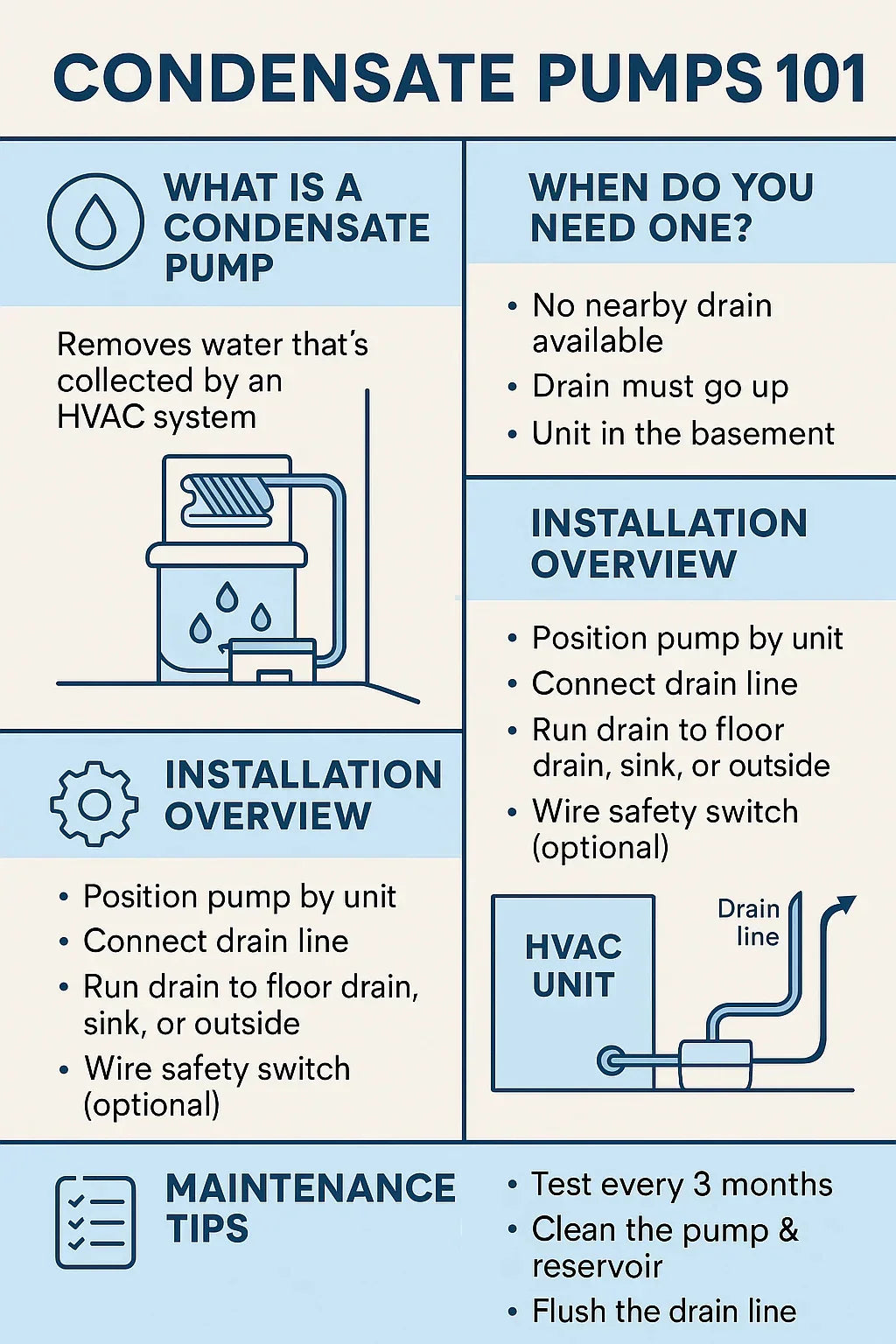If you’ve ever looked at your HVAC system and seen a small plastic box with a drain line running out of it, you’ve probably met the unsung hero of many cooling systems: the condensate pump.
While not every HVAC setup needs one, the homes that do couldn’t run their systems without it—unless they want water pooling around the unit, mold, and damage. This guide will break down what a condensate pump is, when you need one, how to choose the right model, how to install it, and how to keep it working for years.
🧩 1. What is a Condensate Pump?
A condensate pump is a small device that collects and removes the water produced by your HVAC system’s evaporator coil during cooling or dehumidifying.
If gravity can’t carry that water to a safe drain location, a pump steps in.
How it works:
-
Water drips from the evaporator coil into the drain pan.
-
The pan’s outlet sends the water into the pump’s reservoir.
-
When water reaches a certain level, a float switch turns the pump on.
-
The pump pushes water through a discharge line to a drain, sink, or outdoors.
(U.S. DOE)
🏠 2. When You Need a Condensate Pump
You need a pump if:
-
Your HVAC unit is in a basement below the nearest drain line.
-
The drain line must run upward or horizontally for a distance.
-
The unit is in an interior space far from an exterior wall.
-
Gravity drainage is blocked or impractical.
Mark’s Example:
I once installed a heat pump in a basement with no floor drain nearby. The only drainage option was to run a line 8 feet up to the ceiling and across the house to a laundry sink. That job was 100% a condensate pump situation.
📊 3. Types of Condensate Pumps
-
Standard HVAC pumps — Most common for residential cooling systems.
-
Mini-split pumps — Small, quiet pumps that fit inside or near ductless wall units.
-
High-lift pumps — For moving water up long vertical distances.
-
Commercial pumps — Larger capacity for big systems or multiple units.
⚙️ 4. Choosing the Right Pump
Key factors:
-
Flow rate (GPH or LPH) — How much water it can move per hour.
-
Lift capacity (feet or meters) — How high it can pump water vertically.
-
Voltage — Match your system (120V or 230V typical in the U.S.).
-
Reservoir size — Larger tanks mean less frequent cycling.
-
Noise level — Especially important for pumps near living areas.
Rule of Thumb:
Add 2–3 feet to your actual lift height when choosing a pump, to account for friction in the tubing.
🛠 5. How to Install a Condensate Pump
Tools Needed:
-
Screwdriver
-
Tubing cutter or sharp utility knife
-
Level
-
PVC cement (if connecting to rigid pipe)
Step-by-Step:
-
Turn off power to the HVAC unit.
-
Position the pump near the air handler or coil drain outlet.
-
Connect the inlet tubing from the drain pan outlet to the pump reservoir.
-
Run the discharge line to a proper drain or exterior outlet—avoid kinks and dips.
-
Wire the safety switch (optional but recommended) to shut off the HVAC if pump fails.
-
Restore power and pour water into the reservoir to test operation.
🧼 6. Maintenance Tips
-
Check quarterly — Make sure pump activates and drains properly.
-
Clean the reservoir — Remove algae, slime, or debris.
-
Flush discharge line — Prevent clogs from mold or sediment.
-
Test float switch — Lift it manually to confirm pump activation.
-
Replace tubing — If brittle, kinked, or discolored.
🚨 7. Warning Signs of Pump Trouble
-
Water pooling around the unit.
-
Gurgling or buzzing noises without water movement.
-
Short cycling — Pump turns on and off rapidly.
-
HVAC shuts down — Safety switch may be tripping.
🧾 8. Troubleshooting Chart
| Symptom | Likely Cause | Fix |
|---|---|---|
| Pump runs but no water moves | Discharge line clogged | Flush or replace line |
| Pump won’t start | Float switch stuck | Clean or replace switch |
| Pump runs constantly | Leak or switch failure | Inspect lines & replace switch |
| Water leaks from reservoir | Crack in housing | Replace pump |
🛡 9. Adding a Safety Switch
A safety switch wired into the pump can shut off your HVAC if the pump fails or the reservoir overflows.
This prevents water damage and is cheap insurance—especially if your unit is above living space.
📌 10. Key Takeaways
-
Condensate pumps are essential when gravity drainage isn’t possible.
-
Choose by flow rate, lift height, and noise level.
-
Install with a clear, kink-free discharge line.
-
Maintain quarterly to avoid leaks and failures.
-
Add a safety switch for extra protection.
References
In the next topic we will read more about: Wall Sleeves and Grilles: The Unsung Heroes of Through-the-Wall Units







